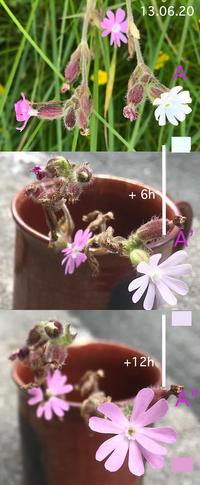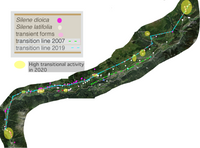S03 - Silene
Another system we are currently investigating is that of Silene dioica - latifolia. We located the system in the Lower Engadine in the east of Switzerland. In 2007 the two forms were interpreted as hybrid forms at 1200 -1400 m of elevation (10.1111/j.1558-5646.2008.00330.x). In contrast to the current situation, where we now assume a transformation process at 1400-1700 m altitude. We will try to support this finding by observation over several years, starting in 2019. Silene dioica has magenta flowers. It occurs in meadows and light woods and is common in early summer. In complete contrast to the white form, which occurs sporadically on a south exposed, well-sunned steep shelves or hedgebanks, and along artificially layered natural stone walls. We suspect that the magenta flowered dioica can transform into the white bloomed latifolia in less than ten years. This system has all the same properties as the Diplacus system also has.
Fig: Combined Phase Space
The width of the corolla in the color space is depicted.
D & l indicate the respective centre of the morph stages.
It includes the rise in the median of the flower width from 18 mm to 26 mm. Also in the same process, one register a fading of the originally magenta-coloured corolla towards white.
What is fundamental and altogether, a sophisticated underlying mechanism may show this suite of pictures. An early stage of transition of an individual plant blossoming flowers having pink but also one white flower (A). If one picks the stem with the flowers and wait for 6 hours the before white flower turns into a pale purplish pink (A'), another 12 hours of waiting gives the before white flower the appearance of a purplish-pink flower A"). We conclude that also here like in Diplacus flowers in transition can gradually change their pigment contents in an efficient direction when environmentally needed.
see: Google Map
Sechs Population ausserhalb Zernez am Inn zusammengefasst im Daumenkino im Lab-Phasenraum 2019 magenta und 2020 grau. Sehr schnelle mittlere Farbveränderung der Blüten dieser Populationen (Stichproben). ◊ = Schwerpukt "Silene dioica"; ◊ = Schwerpunkt "S. latifolia".
Six population outside Zernez along river Inn summarized in the flip-book in the rennet phase space 2019 magenta and 2020 grey. Very fast mean color change of the flowers of these populations (random samples). ◊ = heavy haunted "Silene dioica"; ◊ = heavy haunted "S. latifolia".
Das ist bislang das schnellste System, das wir je angetroffen haben. Es braucht hier offenbar nur fünf Jahre für eine vollständige Umwandlung der magenta Blüten-farbenen S. dioica --T--> in die weiss blühende Silene latifolia. Bei diesem Prozess wird schrittweise die Blütenfärbung, der Blütenduft die Blütengrösse und die saisonale Blütenzeit modifiziert. Die weisse Form blüht abends und nachts, die magenta gefärbte Form am Tag. Die ursprünglich von Hummeln besuchte Blüte von S. dioica wird nach der Umwandlung von dämmerungsaktiven Insekten besucht, die nun durch den intensiven Duft und die weisse Färbung angelockt werden. Das Phänomen ist vom Juni bis Mitte September rund um Zernez 2020 zu sehen.
So far, this is the fastest system we have ever encountered. Apparently, it only takes five years for a complete transformation of the magenta flower colored S. dioica --T--> into the white flowering Silene latifolia. In this process, the flower coloring, the flower scent, the flower size and the seasonal flowering time are modified step by step. The white form blooms in the evening, and at night, the magenta colored form during the day. The flower of S. dioica, which was initially visited by bumblebees, is visited by twilight-active insects after transformation, which is now attracted by the intense scent and white coloring.
Yellow boundaries on the map indicate high transition activity of transient Silene populations in 2019/2020. No more transient activity is seen in 2020 along the 2007 transition line. All checked plant populations along this light green dashed line show stable white-flowered S. latifolia populations now.
r.b. 08-29-20




